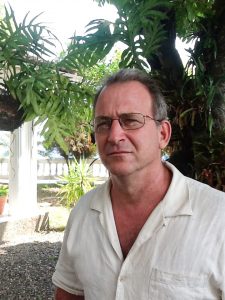The data suggests that Ti Pop should be a clean cut, slightly intellectual, physically fit conservative but stylish teenage female who only comes in contact with soccer balls when practices exploding them with karate kicks. She may or may not be a superhero but, if she is, she should be wearing a cape. There is no indication that her skin colour matters to the target population...
THE TIMOTHY T SCHWARTZ ARCHIVE
THE TIMOTHY SCHWARTZ ARCHIVE
Timothy Schwartz has conducted research and worked on the island of Hispaniola for 27 years. He wrote his Master’s thesis on the impact of emigration on sending communities in Haiti. His PhD dissertation encompassed subsistence strategies, child labor, and marriage patterns in rural Haiti. He lived and worked in Haiti for more than 14 years, including 15 months in a fishing community in a thatch roof hut with a Haitian family and five years in a small farming community.

His popular book, Travesty in Haiti, explores the humanitarian sector from an experiential, largely first person perspective. More recently the Great Haiti Humanitarian Aid Swindle uses his experiences during the 2010 Haiti earthquake relief effort as a launching point to investigate major humanitarian issues that aid agencies have dramatically exaggerated in pursuit of donations and that journalists and activist-scholars have echoed in pursuit of readership and academic tenure.
Food preparation specialists have helped popular class Haitians adapt to deepening poverty while still allowing them to obtain high calories at low cost. In the process they invigorate the local economy and earn income to support themselves and their families. But alternative sources of prepared food have emerged over the last two decades that compete with the local food preparation economy.
This study is about the very important topic of how to get RUFs (Ready to Use Therapeutic Foods) onto the popular Haitian market. Haiti is 1/3rd of an island with a current population between 10 and 11 million people. Until recently the majority of the population lived in rural areas and was dependent on small scale agriculture and livestock rearing...
The objective of this report is to provide project PAER participants and implementing partners with an entry point for understanding the production and marketing strategies among the targeted beneficiaries, to detail programme activities and expected outputs and outcomes. There are some 700,000 women, men, and children in the Department of the North West and the commune of Anse Rouge.
The market research presented in this report is drawn from several phases of investigation in Haiti’s Plateau Central (hereafter referred to as the Plateau) commissioned by the Clinton Foundation (hereon referred to as CF) and facilitated by TechnoServ Haiti, a Non-Governmental Organization (NGO) dedicated to “business solutions to poverty.”
The idea of Frequency Lists comes from the Freelisting technique used in Cultural Consensus Analysis (Romney et. al. 1986; Borgatti 1992). The technique is designed to document categorical knowledge, usually among non-literate people whose folkways are little known outside their living group. For example, a researcher may wish to learn about the types of local foliage rural Haitian leaf doctors use to concoct herbal remedies. The researcher would ask a sample of leaf doctors to give the names of plants they use. The questions are typically asked of 20 to 30 respondents. Responses from the sample of respondents are then correlated.
This study focuses on Haiti's Department of the North West and Northern portion of the Department of the Artibonite. The objectives were to undertake community consultations and field-based assessment in the north-West/upper Artibonite on food security and health to identify most at-risk communities, food supply, coping mechanisms, etc.
Cette étude concerne le département du nord-ouest d'Haïti et la partie nord du département de l'Artibonite. Les objectifs sont de :Réaliser des consultations auprès de la communauté et des évaluations sur le terrain du nord- ouest et du Haut-Artibonite, autour des thèmes de la sécurité alimentaire et de la santé. L’objectif étant d’identifier les collectivités à risque, de comprendre comment fonctionne l'approvisionnement alimentaire, les mécanismes d'adaptation des ménages, etc.
- Timothy T Schwartz
- 2013
- Gender
The quantitative Gender Survey described in this document was part of a larger evaluation and exploration of gender in Leogane and Carrefour, two communes (counties) near to Port-au- Prince that were among those most heavily impacted by the January 12th 2010 earthquake. Following the catastrophe CARE initiated emergency and supportive relief efforts in the communes, including sanitation, health and cash for work programs.
his study responds to a tender from The German Red Cross (GRC) in partnership with the International Federation of the Red Cross, Red Crescent Societies (IFRC) and the Haitian Red Cross (HRC). The objective was to help inform post hurricane Sandy Livelihoods/Food Security interventions to fishing communities in the Departments of the Grand Anse and Nippes.
